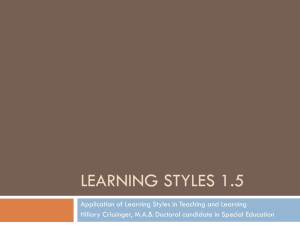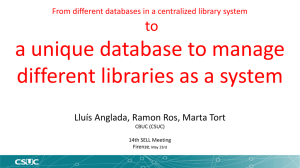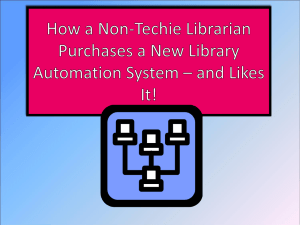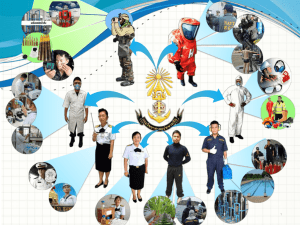Accommodating the learning styles of students in an online learning
advertisement
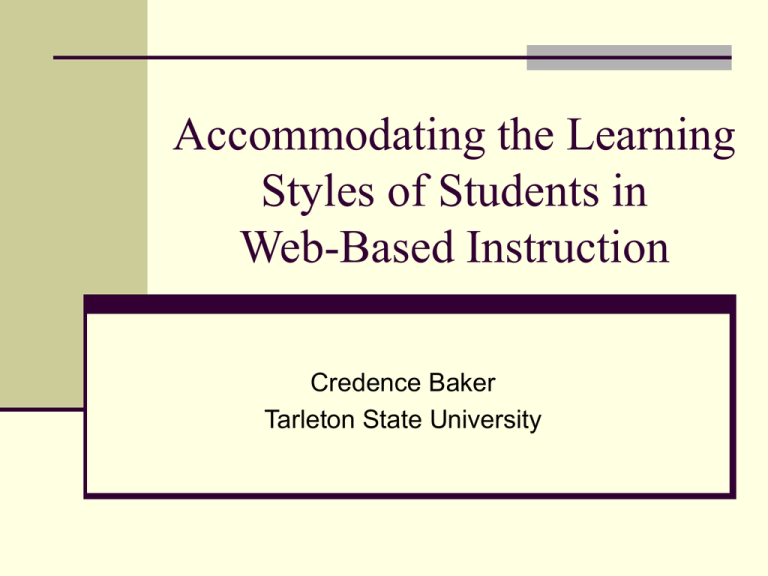
Accommodating the Learning Styles of Students in Web-Based Instruction Credence Baker Tarleton State University Nature of the Research This study sought to determine the learning styles of 192 students enrolled in 22 online classes at Tarleton State University using the Grasha-Riechmann Student Learning Style Scale (GRSLSS) and the Index of Learning Styles questionnaire (ILS). Research Participants A population size of 1100 students and 75 instructors were invited to participate in the study. However, the sample size was smaller as only 29% of online instructors agreed to have their students participate. The study was approved by the Tarleton State University Institutional Review Board (IRB) for use of human subjects. Tarleton’s Course Platform: WebCT WebCT, the official course software of Tarleton State University, is a web based set of course tools designed to deliver online learning. WebCT integrates communication tools, including a bulletin board, chat room, private e-mail, and calendar on the WebCT site. In addition, graphics, video, and audio files can be incorporated. These tools are available only to the students and instructor of the course, thus protecting the intellectual property of the instructor, the privacy of the student, and the course content from external parties. The Grasha-Riechmann Student Learning Style Scale The GRSLSS is ideal for assessing student learning preferences in a college-level distance learning setting because it addresses the impact of different social dynamics on the learning preferences of the students It is a relevant scale to use in a distance setting because it focuses on how students interact with the instructor, other students, and with learning in general (Cartnal and Diaz, 1999). Grasha-Riechmann Student Learning Style Scale Continued… Independent The learner prefers independent study, self-paced instruction and would prefer to work alone on course projects than with other students. Dependent The learner looks to the teacher and to peers as a source of structure and guidance and prefers an authority figure to tell them what to do. Competitive The learner learns in order to perform better than their peers and to receive recognition for their academic accomplishments. Collaborative The learner learns by sharing and through cooperation with the teacher and peers. He or she prefers lectures with small group discussions and group projects. Avoidant The learner is not enthused about attending class or learning class content. He or she is typically uninterested and often overwhelmed by class activities. Participant The learner enjoys class and makes a good class citizen. He or she is interested in class activities and discussions and is eager to do class work. GRSLSS Continued… GRSLSS Learning Style Scales Low Moderate High Independent [1.0-2.7] [2.8-3.8] [3.9-5.0] Avoidant [1.0-1.8] [1.9-3.1] [3.2-5.0] Collaborative [1.0-2.7] [2.8-3.4] [3.5-5.0] Dependent [1.0-2.9] [3.0-4.0] [4.1-5.0] Competitive [1.0-1.7] [1.8-2.8] [2.9-5.0] Participant [1.0-3.0] [3.1-4.1] [4.2-5.0] The Index of Learning Styles Questionnaire The ILS is a 44-question instrument designed to assess preferences on the following four dimensions: sensing or intuitive; visual or verbal; active or reflective; sequential or global The Index of Learning Styles Scale Continued… sensing (concrete thinker, practical, oriented toward facts and procedures) or intuitive (abstract thinker, innovative, oriented toward theories and underlying meanings); visual (prefer visual representations of presented material, such as pictures, diagrams and flow charts) or verbal (prefer written and spoken explanations); active (learn by trying things out, enjoy working in groups) or reflective (learn by thinking things through, prefer working alone or with a single familiar partner); sequential (linear thinking process, learn in small incremental steps) or global (holistic thinking process, learn in large leaps). ILS Continued… ILS Learning Style Scales ACT 11a 9a 7a 5a 3a 1a 1b <-- --> 3b 5b 7b 9b 11b REF SEN 11a 9a 7a 5a 3a 1a 1b <-- --> 3b 5b 7b 9b 11b VIS 11a 9a 7a 5a 3a 1a 1b <-- --> 3b 5b 7b 9b 11b SEQ 11a 9a 7a 5a 3a 1a 1b <-- --> 3b 5b 7b 9b 11b INT VRB GLO Results-GRSLSS The analysis of data for the present study revealed that online students at Tarleton State University are not predominately independent learners (mean = 3.441, moderate), as they were hypothesized to be. In fact, the dependent learning style (mean = 3.772, moderate) was more predominate than the independent. The most commonly preferred learning style according to the GRSLSS was the collaborative learning style (mean = 3.958, high). Conversely, just as other studies (i.e. Cartnal & Diaz, 1999) have shown, the avoidant score (mean = 2.432, moderate) and the competitive score (mean = 2.516, moderate) were considerably less than the other four learning styles (Figure 13). Results Continued… Mean of GRSLSS Learning Styles Represented Overall 3.958 4 3.673 3.441 3.772 3.5 2.516 2.432 3 2.5 Score 2 1.5 1 0.5 0 Independent Score Avoidant Score Collaborative Score Dependent Score GRSLSS Learning Style Com petetive Score Participant Score Results-ILS Online students favored the acting, sensing, visual and sequential side of the ILS continuum rather than the reflecting, intuitive, verbal, and global learning styles side. Results Continued… The ILS scores in online classes at Tarleton State University show a mean of -.26 on the ACT-REF score, -3.08 on the SEN-INT score, -2.95 on the VIS-VRB score, and a -.41 on the SEQ-GLO score. The outcomes of this analysis are shown below: Mean of ILS Learning Styles Represented Overall 0 Score -0.5 -1 -1.5 -0.26 -2 -2.5 -3 -0.41 -3.08 -2.95 -3.5 ACT-REF Score SEN-INT Score VIS-VRB Score ILS Learning Style SEQ-GLO Score Discussion Distance learners are a heterogeneous group, and instructors should design learning activities to capitalize on this diversity. Thompson (1998) noted that since the dynamic nature of the distance population precludes a typical student profile, instructors should continually assess student learner characteristics. The variety of GRSLSS and ILS learning style scores in the present study demonstrates the diversity of learning preferences and illustrates the dynamic nature of online student learning characteristics. Armed with the data collected for this study, online instructors at Tarleton State University can create learning activities and strategies that will appeal to their students' wide variety of learning styles. 10 Learning Style Accommodation Strategies for Online Instructors Credence Baker Tarleton State University Strategy #1 – Online Community Interactivity: The Building Blocks of the Online Community Personal Interaction Online Socialization - Introductions with Responses Post Homepages Q & A Chat Session with Instructor Group Students into smaller groups from Large Classes Infuse personality with tone, graphics and humor Strategy #2 – Web Quest A WebQuest is a form of project-based and problem-based learning in which the resources (and often the tasks and resources) are located on the Web and accessed via links. Examples http://edweb.sdsu.edu/webquest/taskonomy.html Strategy #3 – Net Meetings Real time chat sessions Chat sessions with “experts” Have students prepare questions prior to meeting Example: A Human Resource Management Class could have a director of human resources log-in to WebCT at a certain time with the entire class to conduct a virtual meeting with questions and answers. Strategy #4 – Use Real World Scenarios Access to simulations of processes that cannot feasibly be recreated gives students a chance to ‘situate’ learning that would otherwise remain theoretical. At the same time there are opportunities to allow students to engage in activities which in the real world would be too expensive, dangerous, time-consuming or unethical. As errors are ‘forgiven’, students can learn from their mistakes. Strategy #5 – Video Clips Insert links to video clips that are relevant to the content (example: WebCT Clip) Record personalized video clips and embed them into WebCT (example: instructor introduction) Strategy #6 – Round Table Discussion Use virtual “round table” with audio clips of each persons point of view Example Strategy #7 – Instructor/Expert Narration Use CITDE’s Recording Studio to have “voice over” PowerPoint presentations or notes slides Example Strategy #8 – Break Text into Graphics Break up text and improve appearance and readability with space, graphics, and contrast. Example Strategy # 9 – Virtual Flashcards & Crossword Puzzles Virtual Flashcards allow students to use repetition to learn facts and concepts. Virtual Crossword Puzzles are a great way for students to learn vocabulary. Example Strategy # 10 – Multimedia in Place of Paper Assignments Have students submit assignments in multimedia form (powerpoint, webpages, animations etc.) instead of paper form. Example: Virtual Resume




